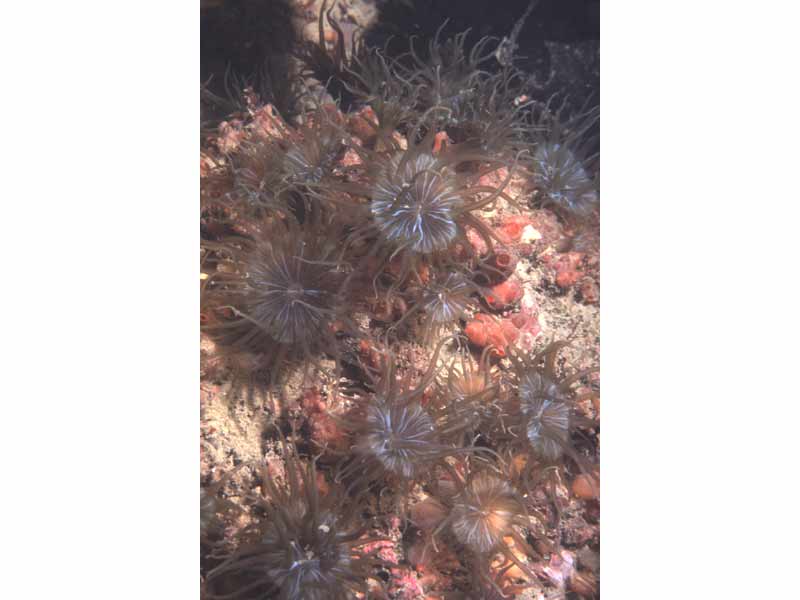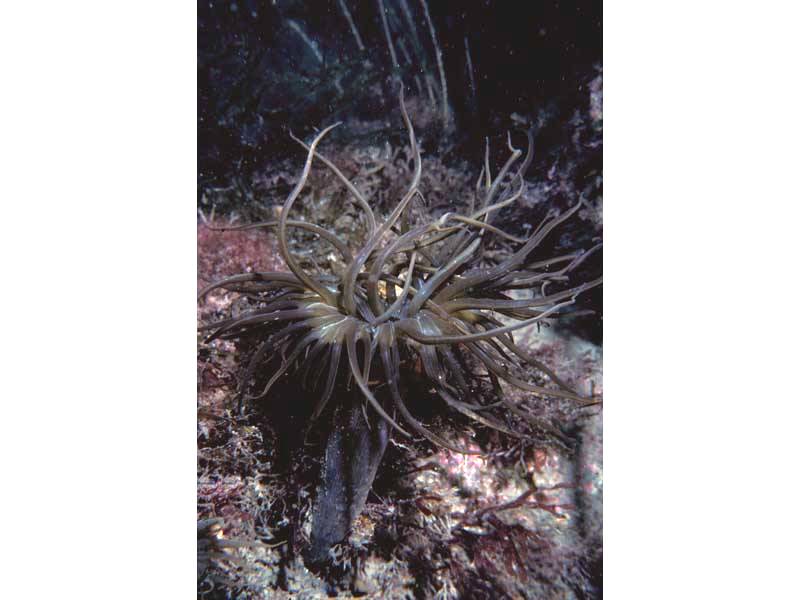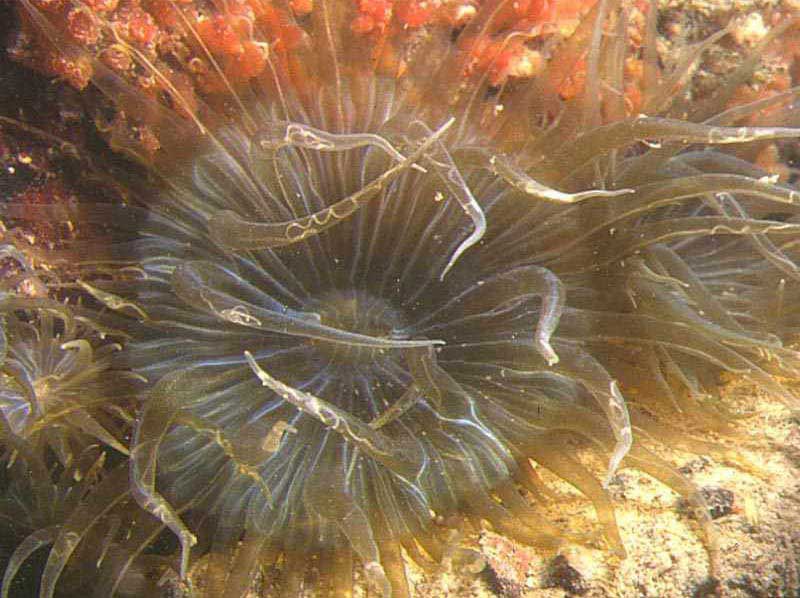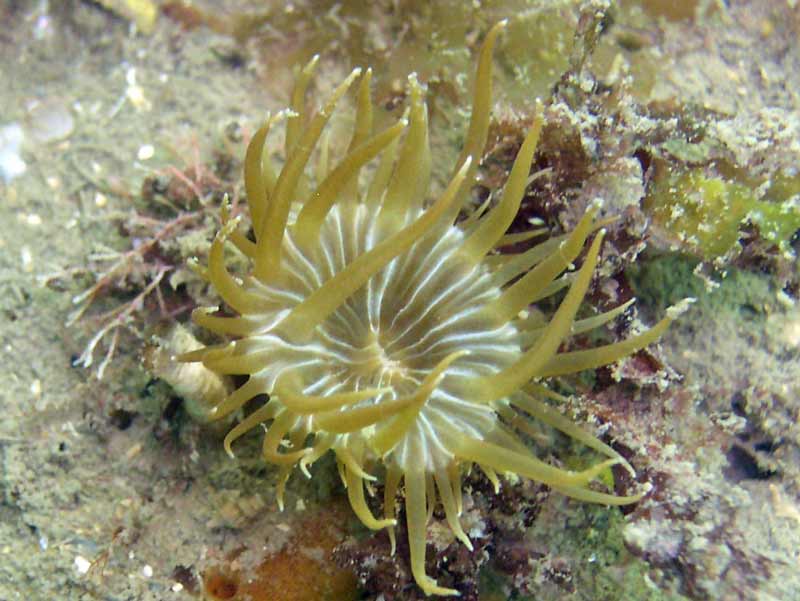Trumpet anemone (Aiptasia couchii)
Distribution data supplied by the Ocean Biodiversity Information System (OBIS). To interrogate UK data visit the NBN Atlas.Map Help
| Researched by | Dr Harvey Tyler-Walters | Refereed by | Admin |
| Authority | Gosse | ||
| Other common names | - | Synonyms | Aiptasia mutabilis (Gravenhorst, 1831) |
Summary
Description
The trumpet anemone has a slender column, with a small base, flaring outwards to the broad oral disc, and typically trumpet-shaped when fully extended. The column can be up to 12 cm in height when fully extended. The tentacles, 48 to 96 in number, are steeply graduated in size. The disc is wider than the column, flat or concave in shape, with the bases of the inner tentacles well spaced out. The inner ones are longer (up to 1.5 cm) than the outer ones (up to 0.5 cm), stout at the base and taper to fine points. They are perfectly retractile but rarely retracted. The span of the tentacles can be up to 15 cm across. The column is translucent brown, palest near the base and shading to dark purplish-brown near the oral disc but with irregular streaks of white along its length. The tentacles and oral disc are also translucent, brown, with whitish radial stripes on the disc.
Recorded distribution in Britain and Ireland
Recorded from North Wales and Pembrokeshire and round the coast of south and west England, including the Scilly Isles. Its occurrence is very localized.Global distribution
Recorded from the eastern Atlantic coasts of Europe, the Canary Islands and Madeira, and into the Mediterranean.Habitat
Found on the lower shore in pools, under stones or beneath overhangs, often amongst algal holdfasts, particularly Laminaria and Saccorhiza. Sometimes abundant on infralittoral rock at wave sheltered locations.Depth range
Lower shore pools, to 5 mIdentifying features
- Lightly adherent base, usually small and rarely much wider than the column.
- The junction between basal disc and column (the limbus) is not sharply defined.
- Tiny perforations (cinclides) fairly prominent in the middle of the column.
- Thread-like acontia emitted reluctantly but often visible through translucent column wall.
Additional information
The taxonomy of Aiptasia and the family Aiptasiidae was revised by Grajales & Rodrigues (2014). As a result, Aiptasia mutabilis was separated into two species, Aiptasia couchii (Cocks, 1851) and Aiptasia mutabilis (Gravenhorst, 1831) on the basis of morphology. Aiptasia mutabilis is now known to occur only in the Mediterranean and prior UK records are considered to be Aiptasia couchii. Note, it may take sometime for prior records to be remapped appropriately.Listed by
- none -
Bibliography
Hayward, P., Nelson-Smith, T. & Shields, C. 1996. Collins pocket guide. Sea shore of Britain and northern Europe. London: HarperCollins.
Hayward, P.J. & Ryland, J.S. (ed.) 1995b. Handbook of the marine fauna of North-West Europe. Oxford: Oxford University Press.
Manuel, R.L., 1988. British Anthozoa. Synopses of the British Fauna (New Series) (ed. D.M. Kermack & R.S.K. Barnes). The Linnean Society of London [Synopses of the British Fauna No. 18.]. DOI https://doi.org/10.1002/iroh.19810660505
- Grajales, A. & Rodriguez, E., 2014. Morphological revision of the genus Aiptasia and the family Aiptasiidae (Cnidaria, Actiniaria, Metridioidea). Zootaxa, 3826 (1), 055-100. DOI http://dx.doi.org/10.11646/zootaxa.3826.1.2
- Wood, C., 2013. Sea anemones and corals of Briain and Ireland, 2 edn. Wild Nature Press, Plymouth, UK.
Datasets
Isle of Wight Local Records Centre, 2017. Isle of Wight Notable Species. Occurrence dataset: https://doi.org/10.15468/sm4ety accessed via GBIF.org on 2018-09-27.
OBIS (Ocean Biodiversity Information System), 2025. Global map of species distribution using gridded data. Available from: Ocean Biogeographic Information System. www.iobis.org. Accessed: 2025-01-15
Citation
This review can be cited as:
Last Updated: 15/01/2020






